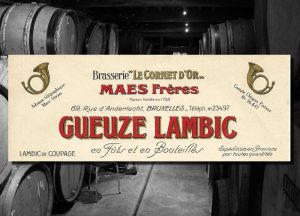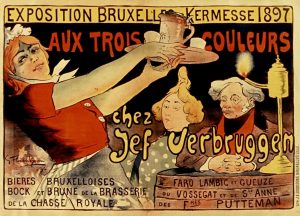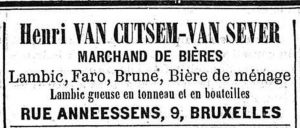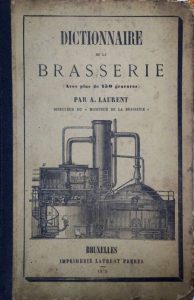Gueuze in barrels (1)
 Gueuze: the Belgian beer style known as the ‘champagne among beers’. After all, this spontaneously fermented beer belongs in a bottle, where it can develop its foam that joyously bursts in all directions when the cork pops out. Right? So why do I keep finding old newspaper ads where gueuze is advertised… in barrels?
Gueuze: the Belgian beer style known as the ‘champagne among beers’. After all, this spontaneously fermented beer belongs in a bottle, where it can develop its foam that joyously bursts in all directions when the cork pops out. Right? So why do I keep finding old newspaper ads where gueuze is advertised… in barrels?
Lately, after writing about the history of Dutch beer in my book Verloren Bieren van Nederland (Lost Beers of the Netherlands), I’ve been looking into the beers of Belgium. And the Belgian beer that is most praised by its connoisseurs, is gueuze. A wonderfully sour but quenching beer, which has acquired a large international following, and rightly so. Americans pay lots of money to acquire a bottle of this sought-after drink, because there aren’t that many gueuze brewers and blenders that can make this beer, almost all of them in and around Brussels.
But what is gueuze? Today, the answer is clear: according to brewers association HORAL there is the basic beer called lambic, that is aged for a few years in barrels, and we speak of gueuze (or, more correctly, of ‘gueuze-lambic’) as soon as the lambic has been blended with young beer and then bottled. Only Gueuzerie Tilquin recenlty started selling gueuze on draught, though in their barrels there is a refermentation as well.
However, in 1893 one Henri Van Cutsem-Van Sever, beer trader in the Rue Anneessens in Brussels, advertised ‘lambic gueuse en tonneau et en bouteilles’, which means ‘in barrels and in bottles’. Or what about this: three years earlier, during local festivities, the famous Manneken Pis statue was connected to barrel of Bordeaux wine (the little statue ‘peed’ it for everyone to drink), but after that also to a ‘tonneau de “gueuse” lambic’! In 1895 the Brussels brewery Ver Elst Van Hoomissen received a golden medal at the World Fair in Amsterdam for its renowned beer: ‘Gueuse Lambic, en fûts et en bouteilles’. In barrels and in bottles.[1]
It would seem that, despite the claims made by HORAL and various Belgian beer writers, in the 19th century gueuze wasn’t a bottled beer by definition at all. So what was it? The oldest sources speak only of faro (from 1721 onwards) and lambic (starting in 1794). Gueuze isn’t mentioned until 1829, by dr. Jean-Baptiste Vrancken from Leuven. Vrancken wrote that the lambic brewed by private persons and then aged for five years was called ‘geuze-bier’. He described it as ‘the real yellow beer of Brussels’ and wrote that it was still foaming when it was put in bottles, after which here was a second fermentation inside the bottles, even though the beer itself was not at all sweet anymore.[2]
In any case, this writer speaks of bottles, but other texts show that bottles weren’t the main characteristic. In 1875 the originally Northern French beer professional Auguste Laurent wrote: ‘Lambic and gueuze are like brother and sister, the first one is clarified and then sugar is added to it, while the other one is aged and becomes clear without any preparation. It is Brabant’s best beer.’ Eight years later, Laurent simply wrote: ‘Gueuze is pure, unsweetened and unprepared lambic.’[3]
According to Laurent gueuze mainly was not prepared in any way, but other writers emphasise its age: ‘Lambic sometimes only becomes mature after three, four or even five years. That gives a product in which a great sourness dominates, and that is usually called ‘gueuse lambic’,’ wrote Mr. Van den Hulle and Mr. Van Laer of the Gent brewing school in 1891. They say gueuze was sweetened before it was sold.[4] Also the French beer professors Moreau and Lévy repeated in 1905: ‘old lambic is usually called ‘gueuse-lambick’.’[5]
So what do we learn from this? First there were the spontaneously fermented Brussels beer types faro and lambic, and at a certain moment they were joined by a special kind of lambic, the gueuze-lambic. And initially it was mainly regarded as an ordinary lambic, but aged, and not blended with young beer. In barrels, or in bottles. As early as 1831, a document mentions two barrels of gueuze-lambic.[6] That said, there are a few early reports of gueuze-lambic in bottles, like in 1844 when 200 bottles were shipped to Constantinople and 500 to Rio de Janeiro.[7]
Ordinary lambic was however bottled as well, and just to name an example, in 1848 the parish priest of the village of Haaltert had no less than 150 bottles of it in his cellar.[8] Gueuze in bottles apparently only started to be of some importance at the end of the nineteenth century, because only by then it regularly features in newspapers. For instance, in 1895 a worker for a beer trader in Laken had the unpleasant experience of a bottle of gueuze-lambic exploding in his hand. In 1898 the same happened to a brewer’s boy on Boulevard Baudouin while filling bottles.[9]

At the 1897 World Fair quite a lot of gueuze was sold, but lambic and faro sold even better. Source: Bibliothèque Nationale, Paris.
By that time gueuze-lambic had more or less become a separate beer type, the most expensive one in Brussels. For instance, in 1892 a bottle of lambic cost 35 cents, but gueuse-lambic 40 cents.[10] At the 1897 Brussels World Fair, quite a lot of gueuze-lambic was drunk at the brewery stands (4,405 litres), although that was still peanuts compared to the consumption of ordinary lambic (12,417 litres) and faro (49,516 litres); total beer turnover was 134,241 litres including bock beer, Münchener and Bavarian beer.[11]
Anyway, how did gueuze evolve from the definition ‘older and therefore more expensive lambic’ to today’s ‘champagne-like lambic in bottles’? And why is ordinary lambic itself not old separately on the market anymore? We will look into that the next time.
[1] Le Peuple 2-7-1893, 26-6-1890; Le soir 1-9-1895.
[2] Jean Baptiste Vrancken, ‘Antwoord op vraag 81’, in: Nieuwe verhandelingen van het Bataafsch Genootschap der Proefondervindelijke Wijsbegeerte te Rotterdam, Rotterdam 1829.
[3] A. Laurent, Dictionnaire de la brasserie, Brussels 1875, p. 154; A. Laurent, Bruxelles, ses estaminets et ses bières, Brussels 1883, p. 76.
[4] L. Van den Hulle and Henri Van Laer, Nouvelles recherches sur les bières Bruxelloises à fermentation dite spontanée, Brussels 1891, p. 4.
[5] G. Moreau and Lucien Lévy, Traité complet de la fabrication des bières, Paris 1905.
[6] https://www.pajottenland.be/Data/Web/Versie2/mysterielambik.php; On https://lambik1801.wordpress.com/2015/10/18/oude-en-nieuwe-geuze/ Raf Meerts gives a mention of ‘two barrels of Geus Lambicq’ from 1836, but he provides no source.
[7] L’Indépendance Belge 18-10-1844, 20-10-1844.
[8] Denderbode 23-1-1848.
[9] Le Courrier de l’Escaut 6-4-1895; Le journal de Bruxelles 13-10-1898.
[10] Le Soir 29-7-1892.
[11] Het laatste nieuws 15-11-1897; Le journal de Bruxelles 15-11-1897.









Really interesting information. I’m looking forward to seeing more posts like this in the future
Fascinating, thank you. When you ask why ordinary lambic is not sold separately anymore, what exactly are you referring to? Young, non-barrel aged spontaneously-fermented beer? (As you know, there are certainly bottles of beer labelled “lambic” on the market today – such as De Cam’s Oude Lambiek, for example).